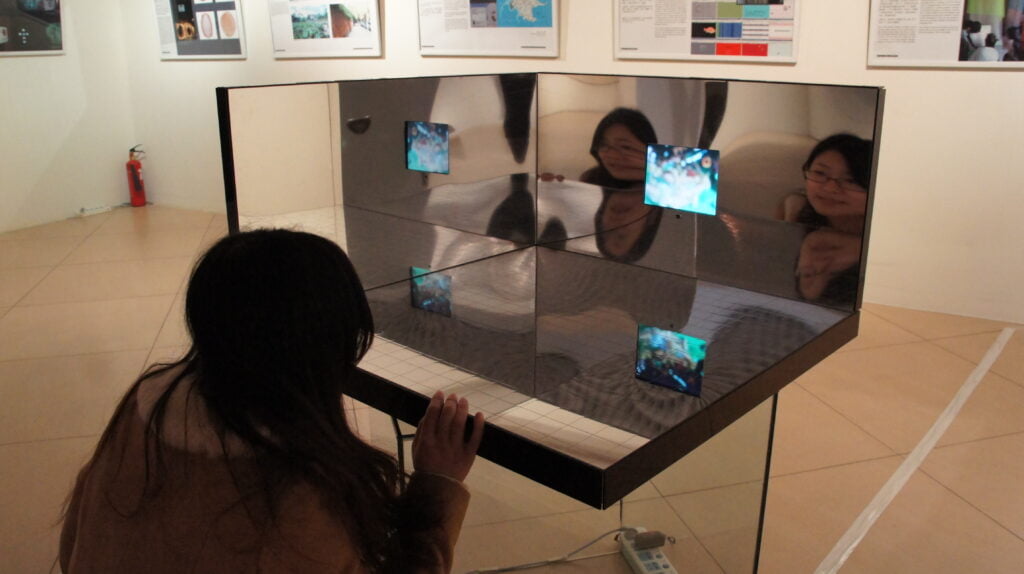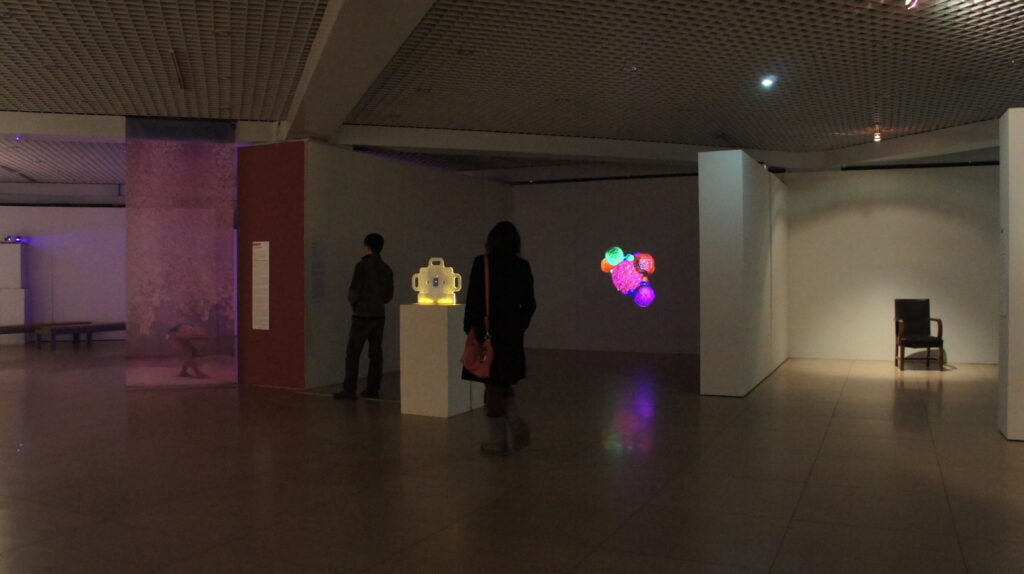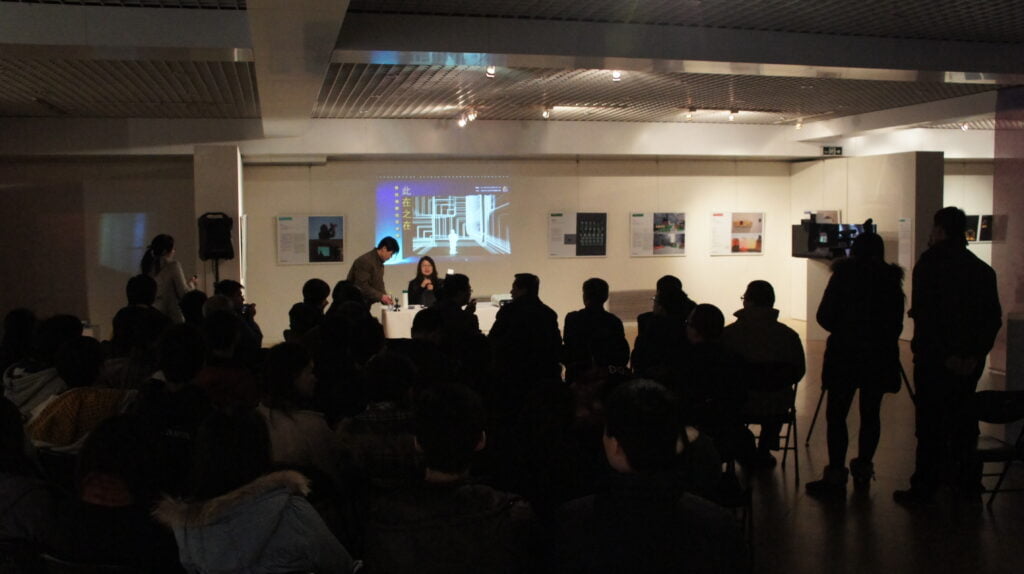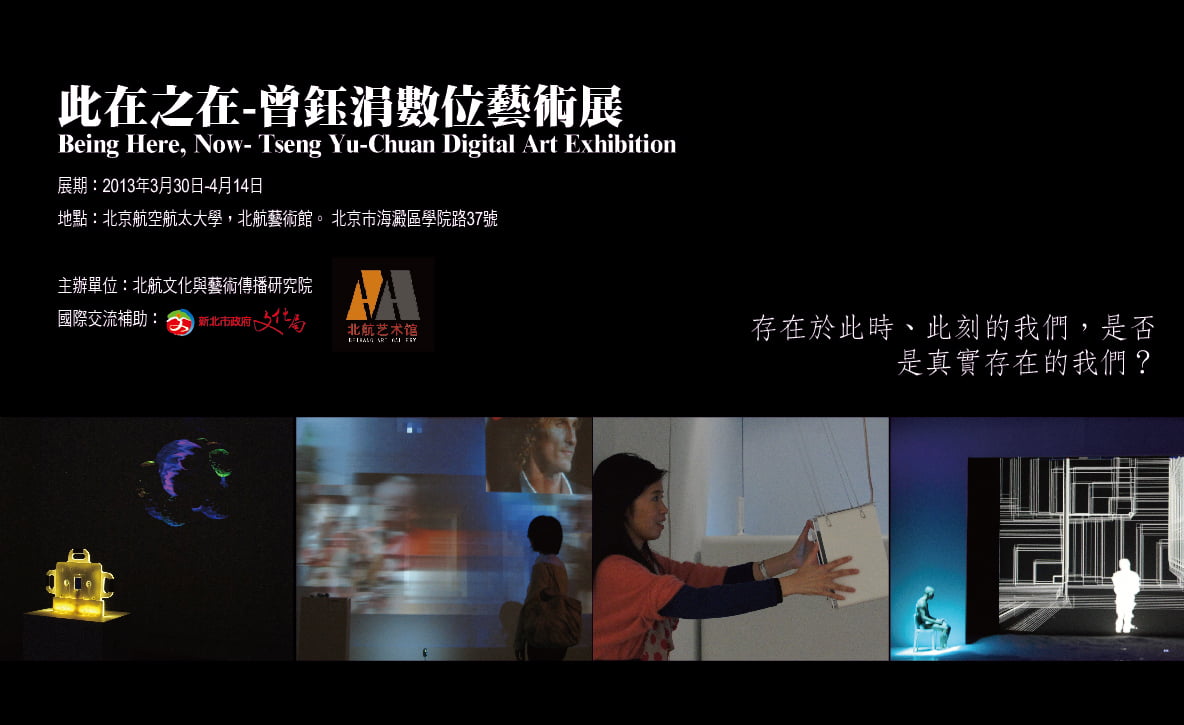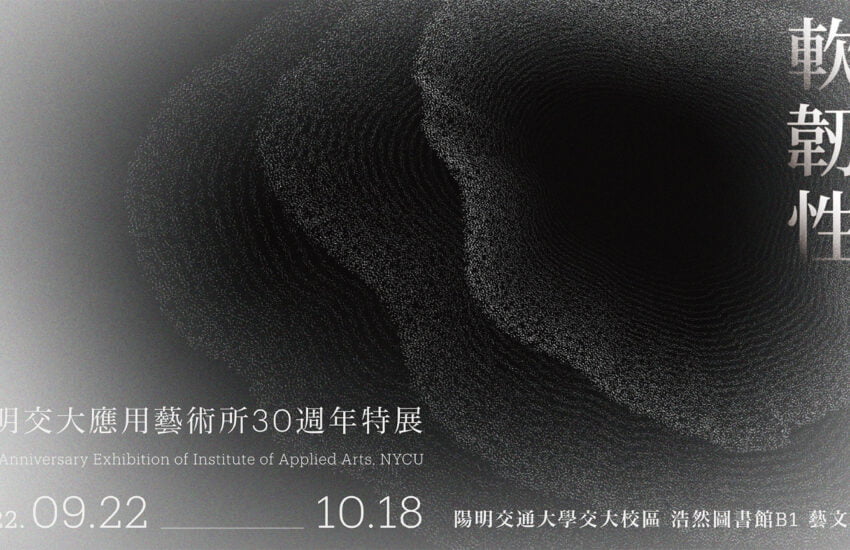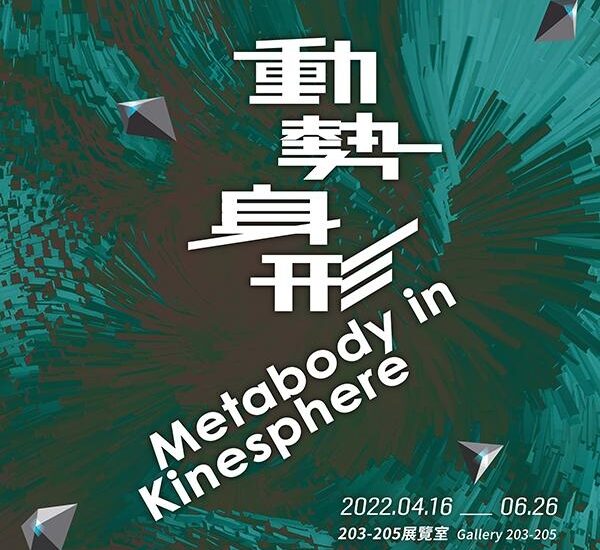Being here, now: Yu-Chuan Tseng Solo Exhibition
Date: 2013/3/30-4/14
Place: Art and Culture Center of BUAA, Beijing, China
Do we genuinely exist? Are we, who exist through electronic signals, really our true selves?
In our current world, a world in which the virtual and the real interweave in the human consciousness, humans exist as electronic signals. How are we to view or conceive of the existence of this world? Moreover, how should we perceive our own existence?
In 1876, Bell invented the telephone. In doing so, he took human language signals at two separate “points” and connected them, enabling humans to converse at distance instantaneously. The internet, on the other hand, works via an interconnected net made up of “lines” (cables). These lines transport human signals and thought, presenting them on a screen in a variety of forms, such as text, images, audio, and video. In doing so, these “lines” produce elements made of both the real and the virtual, and thread together and interweave to create a world of patterned “squares”. The identity of the self who takes part in this virtual world is multi-faceted, fluid, illusory. Those who do participate enjoy the thrill of the interaction between real and virtual. In the 21st century, electronic signals are the means through which humans prove their existence. Every single “point” (hub) toward which internet and phone signals flow, serves as evidence of the existence of each individual self. Through these “points”, people transmit signals about their own self-existence and respond to other people’s existence. In this process of back-and-forth, mutual interaction, digital code edits its own data – all the signals that represent human existence – such as sounds, images, and text, and this information is collected to form a database stored at the remote end of the internet. This virtual database becomes a vast “backup system” for the memories of countless individuals, and even replaces the individual, to become the principle entity existing within this virtual world. The trails left behind in internet browsing become the footprints of real activity in one’s life. The database stores memories of the individual, who wanders along the path of virtual space. In doing so, it constructs a virtual pathway of movement through which the individual shares their life with others. Each of these “points”, or individual users, is connected by “lines” (cables) which interlace and criss-cross to form a “net”. This all-encompassing “net” consists of “squares” of space. And it is within these “squares” that people construct their existence, take part in interactive social networks, and create new value in their lives, new patterns of thinking and perceiving.
In an interview in 1996, Jean Baudrillard expressed his views on the then new technology known as the internet. Baudrillard believes that “Virtuality retranscribes everything in its space; in a way, human ends vanish into thin air in virtuality. It is not a doom-laden danger in the sense of an explosion, but rather a passage through an indefinable space. A kind of radical uncertainty…This will become so obvious that there will no longer even be any problems concerning liberty or identity. There will no longer be any way for them to arise…The media neutralizes everything”[1].
Starting from 2003, I began to examine the existence of mankind in the digital age, and, through a series of works, explored this digital system – built of technology – which brings together the lifestyle, lives, and means of survival of the masses. In this simulacrum of reality, signals are translated and restructured, and then appear once again as electronic signals that re-transmit the emotions of human beings. In this process, human beings, although seemingly assertive and in control, have lost their sense of power and control. Through digital signals, human beings connect to a virtual world, a “motherboard”. As these signals are transmitted back and forth, human beings sit in front of their screens, passively in control, waiting to receive the signals that exist and believing – throughout this entire process – that they themselves exist.
However, are the people who exist at this particular point in time, this instant, truly us?
When one’s body turns into code in a database, is it no longer something that belongs to the individual, and instead a piece of data that exists through digital signals?
Does an image, which is a visual recreation of the status of one’s existence, symbolize that the individual truly exists?
When this image, through the use of digital signals, merges with the data of others, does the appearance of the original image continue to exist?
Can this illusory image – the hybrid of several separate images – with its blurry, indefinable features, represent either the individual or the masses?
With these questions as a conceptual framework, my artwork employs various forms of digital interaction, inviting visitors to become participants and create visual material through their actions and movements. In doing so, they provide images, memories, written text, and signals that are gathered up to form a database of collective consciousness. When information that participants provide about themselves turns into content in the database, and after it becomes an integral part of the art display’s digital system, the information not only becomes removed from the consciousness of the visitor, but is also removed from its original context and meaning. It becomes an individual element that exists on its own, devoid of its original identity or the meaning it originally possessed. The person’s perception of their own identity is buried and dissipates. Yet through this digital process – one of “program code and logic”; a process which is “random, automated, and derivative”, and that contains “logic, procedures, and systems” – the information is restructured and recreated; it takes on a new meaning and becomes an entity that exists individually. It is through this process that the meaning and subjectivity of the artwork is born[2].
“Let’s Make Art” (2003) is an art display that invites internet users, via the internet, to “make art” together. When users upload an image onto the exhibit’s computer program, the image is converted into code. The program randomly creates colored code, and then, in this coded format, the pictures are printed out and placed on display at the exhibit (held at the Taipei Fine Arts Museum). The actions and the artwork of participants turn into an element in the exhibit’s computer system and a focal point for discussion in the art system. “All Ways – O’s Chat room” (2003), on the other hand, draws from a database to create an interactive dialogue system that proffers random and sometimes absurd responses. The host of this chat room – and the virtualized embodiment of this chat system – is a program called “Mr. O”. Mr. O collects words and phrases from participant dialogue to form a “language and knowledge” database. This database then forms the source of Mr. O’s conversations with other participants. Therefore, the more participants present, the larger the “pool” of language and knowledge from which Mr. O can draw. This database – composed of the words and thoughts of the masses – is a reflection of the collective consciousness that exists among the populace.
“Fuse” (2004) invites participants to use their mobile phones to send an image to the computer system at the display. After being projected onto the main display monitor, the image is then converted into code. A program on the computer measures the color composition of the original image and, accordingly, transforms it into a speck of color, which is then randomly positioned among the other, already-existing colored dots to form a constantly-evolving, speckled pattern. The original picture uploaded by the participant represents the memory of the individual; a fragmented slice of human experience. As it dissipates from the screen, the image is destroyed and so, too, is the individual memory, which turns into just one memory among the collective memories of the masses. The dotted pattern produced represents the existence of this collective memory. Yet when a new image appears, the collective memory is again covered up in an endless process of creation and recreation. “Immersing Me” (2005) and “Who” (2008) discuss the subject of human existence. They explore issues on the way in which people exist in the digital age. Together, they pose the following question: when digital technology pervades the individual being, becoming a signal or symbol of one’s existence, or an extension of the human body; when this individual uses a system of data conversion and exchange to prove that he/she exists, then who, actually, are we?
“Immersing Me” is a display that incorporates a “Human Body Measurement Lab”. It invites participants to place themselves in front of six separate cameras that film six different parts of the body: the head, chest, left arm, right arm, waist, and legs. The information obtained is then displayed on six separate monitors, which are arranged in the shape of a cross, with each monitor representing a corresponding part of the body. In addition, a separate projection screen provides an overall view of these six monitors. On this screen, the pixels from each of the six monitors begin to move and then flow into each of the other monitors. This altered image, however, is merely a fleeting interlude; as, in the end, it blends into the flowing electric signal to form one single speck of light.
“Who” comprises four separate sections: “Question”, “Dialogue”, “At the Display?”, and “Shadow” to explore the actual physical presence of humans in the digital age. The first part, “Question”, involves a robot that continually asks participants the question “Who are you?” Using a remote control device, participants summon the robot and answer the robot’s questions. Their answers are recorded and their faces filmed. From then on, each time the robot talks to Participant A, for example, it changes its own appearance to reflect that of Participant A, thus becoming an “avatar” of Participant A. How should the participant respond to a robot whose face is identical to his/her own? This feeling is somewhat akin to being transformed into someone else, someone who exists in the mind’s eye of the participant; but at the same time, it is like looking at someone who seems very familiar. As the robot continually asks the question “Who are you?”, the participant begins to rethink their own personal existence. In the second part, “Dialogue”, two robots engage in a dialogue consisting of the verbal response provided by the participant in section one. When participants approach the robots, the robots sense this and turn their heads to face the participant, creating the false impression that the robots can actually feel the presence of humans. Of course, this is merely an illusion. The content of the robots’ dialogue is intricately connected to the psyche of the participant. This artwork is a modern adaptation of the piece “TV Buddha”, created by Nam June Paik in 1974. When two robots, with the face of the participant, engage in mutual conversation, it creates a vivid contrast between the real and the illusory. The third part, “At the Display?”, incorporates the image portraits of the participants taken in section one. It randomly selects two such portraits that are displayed as the “faces” of the robots. These portraits then become fragmented, falling apart and turning into countless dots that float about and then reassemble to create fuzzy, unclear digital portraits. This process is a metaphor. It represents the uncertainty and sense of fragmentation of portraits in the digital age. In such an age, people’s pictures are taken and stored as digital files. As these files are encoded and re-encoded, they turn into computer code: 0s and 1s. In this process, the original self of the person in the photograph is lost. They are there, but not really there. The fourth part, “Shadow”, involves a dark room and a large projection screen. On the screen, the participants’ pictures are projected and overlap to create the effect of a large digital collage, a record of each participant’s existence. As time goes by, the images go from clear to blurry, from close up to far away. As this process repeats itself over and over, the appearance of the images becomes distorted and unclear. In this dark room, visitors hold candles and ceremonially search for their picture among the projected images. The picture they eventually select, instead of being enlarged, actually turns into a speck of light and disappears, reflecting the elusive and temporal nature of digital images.
“Where Are You?” (2010) requires the participant to enter the name they wish to search for online, find a related image, and capture the facial component of this image to construct a portrait. The portrait is testimony that the participant truly existed at the display, at the “user end”. The portrait is then transmitted to the other side of the world, the “remote end”, where it takes the individual’s true existence and, using electronic signals, recodes it. In this flow of electronic signals, the individual loses their uniqueness. As they become recoded along with everyone else, their appearance is altered. They become present, at the display, but not really present. As electronic signals are sent out and new ones received, the individual imagines their existence through the eyes of others. However, are those who exist at this time, this very instant, really our true selves? “Chimeras Sing a Song”(2012) discusses the issue of cyborg. These humans use digital devices and transmit digital signals to create their own means of survival. In today’s world, digital tools have become an extension of the human body. Human memory and digital memory now mix and interact in both real and virtual space to form a hybrid entity capable of evolving and reproducing.
In this simulacrum of reality, signals are translated and restructured, and then appear once again as electronic signals that re-transmit the emotions of human beings. In this process, human beings – although seemingly assertive and in control – have in fact lost their sense of power and control. Through digital signals, human beings connect to this virtual world, to this “motherboard”. As these signals are transmitted back and forth, human beings sit in front of their screens, passively in control, waiting to receive the signals that exist and believing – throughout this entire process – that they themselves exist. However, are the people who exist at this particular point in time, this instant, truly us? Baudrillard believes that “When the world or all that is real views virtual objects as the equivalent of man-made objects, then this real world becomes extraneous; when a race of people must propagate itself through the use of cloning, then gender becomes extraneous; when everything is reduced to computerized or neurological networks, then the human body becomes extraneous…” In our current society, spawned from digital culture, human beings have rendered their own bodies extraneous and allowed human awareness to now be stored in digital devices. Within this paradigm, human beings have become a people that cease to exist.
[1] Interview by Claude Thibaut, Translation: Suzanne Falcone, 1996
“Baudrillard on the New Technologies:An interview with Claude Thibaut”
http://www.egs.edu/faculty/jean-baudrillard/articles/baudrillard-on-the-new-technologies-an-interview-with-claude-thibaut/
[2] Tseng Yu-chuan, The Characteristics of Contemporary Interactive Digital Art, National Chiao Tung University, 2010, Hsinchu City.
—————————————————————–
此在之在 /曾鈺涓
我們是否真實存在,訊息存在的方式,是否可以代表真實的自己?
人類以訊息存在於此虛擬與真實混雜知覺的世界中,我們該如何觀看,感知世界的存在,並意識自身的存在。
1876年,貝爾發明了電話,將人的語言訊息,藉由點對點的串連,即時溝通接觸。而網路則是藉由「線」織成的網絡,將人的訊息與思想,以文字、圖像、聲音、影音等各種展演形式,變成各種擬真的元素,形成「面」的空間。參與虛擬世界的身份自我,是多元的、流動的、虛擬的。進入這個虛擬空間裡的參與者,在這裡享受擬真的快感。二十一世紀,訊息是人們證實存在的方式,每一個網路、電話訊息端「點」,都是人們證實自身存在的證明。透過「點」,送出自身存在的訊息,回饋他人存在的訊號,在往來與彼此互動中,讓數位編碼重新編譯自已的聲音、影像、文字等代表自身存在的訊息,成為儲存於遠端網路的資料庫。網路資料庫成為個人大腦記憶的備份組織,甚或替代個人成為存在於網路之中的主體。網路瀏覽軌跡,成為生命活動的軌跡,儲存記憶個人遊走於虛擬時空的脈絡狀態,建構與他人分享的虛擬行進動線。各個端「點」,藉由「線」織成的網絡,以網格形成「面」的空間,建構眾人存在、參與互動社群,也建構新的生命價值與思考感知的模式。
Jean Baudrillard(布西亞)在1996年接受訪問中曾提出對網路新科技的看法,他認為:「…….. 虛擬的世界裡,「虛擬」將所有的事物再解譯,某種形式上,人類在虛擬裡消失成空氣,那不是一種爆炸注定毀滅的危險,而是一個模糊的、無法確定存在的空間,一種極端的不可靠空間…….很明顯地,也無須去關心自由(Liberty)與身份(Identidy),因為它們根本沒有產生。….這個媒體中和了所有的事物[1]」。
2003年開始思考數位時代中「人」的存在狀態,以一系列作品討論,此由科技構築的系統,集合眾人生活、生命與生存的所在。在訊號編譯與重組之後,電訊再現與重新傳播人類情感原件之擬彷,此過程使得人類在虛假的主動控制行為中,失去做為主體的權力。人類藉由數位訊號連結母體,在訊號傳送之間,被動的主動控制行為中,接收存在訊號,想像自我的存在。
然而存在於此時、此刻的我們,是否是真實存在的我們?
當身體成為編碼與資料庫時,身體是否已經不再成為個人的所有物,而成為以數位訊號方式存在的訊息?
以影像作為存在狀態的視覺再現,是否能代表存在的狀態?
當此影像以數位訊號狀態與他者的訊息匯流,原貌是否仍然存在?
此種虛幻的影像,無法言說的模糊狀態,是否能成為個人、抑或眾人的表徵?
在此創作脈絡之下,以數位互動做為創作媒介,邀請觀者成為參與者,以身體動作為介面,提供影像、記憶、文字與訊號,建立共同的集體意識資料庫。當觀者提供的自身訊息,成為資料庫的內容,並成為作品系統的重要元件之後,此資料訊息也不僅自參與者的意識脫離,也脫離其原有的訊息意義,獨立存在於訊息之中,無法辨識其原有的個別身分意義,「人」的重要身分認知被消蝕與淹沒,卻在「程式編碼與邏輯」、「隨機、自動化與衍生」與「邏輯、程序與系統」的重組與再現中,重新建立了意義,成為具獨立存在的個體,也建構了作品的整體意義與主體性。[2]
《Let’s Make ART》(2003)透過網路邀請網友一起來「做藝術」,當網友上傳影像作品後,影像作品卻在程式系統的運作中,轉換成為編碼,並由程式隨機給予編碼色彩呈現後,以編碼形式再現列印,被裝裱展覽於台北市立美術館。參與者的行動與作品,成為程式系統的一個因子,也成為藝術系統中被討論的對象。《All Ways – O的聊天室》(2003)則以資料庫建構隨機與無稽回應的對話系統。聊天室中的系統化身為聊天室主人「O」,收集參與者的對話,建構「語詞知識系統」資料庫,作為「O」與參與者聊天的對話來源。當參與者登入聊天時,程式以隨機的方式,隨意挑選並回應對方。因此,參與的人越多,「O」的「語詞知識系統」愈龐大,對話方式與特質也隨著變化。由眾人所組構的資料庫「語詞知識系統」,即是一種眾人的集體存在意識狀態。
《FUSE》(2004)邀請參與者將手機拍攝的影像上傳至作品系統,成為圖像編碼後再以程式計算圖像的色彩組成,歸納並轉化為色點後,隨機選擇座標方向扭曲遊走,影像彼此消融,不斷地再組構出新影像。攝影影像隱喻個人的記憶,是個人記憶的切片,此消融的過程,破壞影像視覺性,也破壞了個人記憶,與他人記憶消融成為眾人的集體記憶,再現的影像呈現出集體記憶的存在,卻又在新的影像出現時,被覆蓋並重複此一無盡的再現過程。《Immersing ME》(2005)與《Who》(2008)以「人的存在」為討論對象,討論數位時代,人存在於此的狀態問題。詢問當數位科技滲入個體,成為自己存在訊號,或科技身體延伸的一部份,當個體透過訊息轉譯與交換所建構的存在系統,證實自身的存在,你到底是誰?
《Immersing ME》以「人體測量室」為測量身體的攝影空間,邀請參與者置入拍攝框架中,使用六具網路攝影機,分別拍攝身體的頭、胸、左手、右手、腰部與腳部,再以十字架形式,依照身體部位重新排列參與者的身體訊息。投影機投射此以十字架方式排列的六張影像,並將六張影像之圖素相互浸入。重新組構影像的六個螢幕,在此僅是一種宣示,一種過場,存在的訊息,最終仍是化為光點,消融於訊號流之中。
《Who》則是以四件作品〈問〉、〈對話〉、〈在場〉、〈影〉討論數位時代的“人”之在場與不在場。〈問〉是一具不斷詢問觀者問題「你是誰」的機器人,參與者透過手中的玩具召喚機器人並回答問題,此互動過程中,觀者的回應被錄音,臉部被攝影。此過程形成自我參照的程序,當參與者甲成為機器人參照的對象時,機器人即成為甲的替身(Avator),參與者該如何面對具自己外觀的機器人,此感受像是自我內心的他者之甦醒,但卻又像是面對著熟悉的他人,在不斷的詢問過程中,重新思考個人存在的問題。〈對話〉以參與者的回應錄音,作為兩具不斷彼此對話機器人的說話內容。當觀者進入此對話空間時,機器人會感應觀者存在並轉動頭部,產生理解人之存在的虛幻想像。然而機器人當然並非真實理解人的召喚,其之間對話意義的形成,關乎觀看者的心。此作品回應白南準的作品《TV Buddha》(1974),當具觀者面孔的兩個機器人,面對面對話時,形成一種虛與實的對照。〈在場〉以〈問〉中被攝影臉部的觀眾肖像,隨機挑選兩位呈現,並碎裂成點並漂移重組產生模糊的數位肖像,象徵著數位時代肖像的不確定與碎裂感,人被拍攝與儲存成為數位檔,在被解碼與重新編碼成為0與1的過程中,失去了本我,我們成為在場之不在場的他者。〈影〉則將現場觀者影像投影於牆面上的壁上繪畫,與之前被拍攝之觀者影像重疊於壁面上,在暗黑的空間中,呈現出存在記錄。觀者影像隨著時間流逝,從清晰到模糊、也從近處到遠處,此因時間所產生的層層疊疊狀態,呈現出模糊不清與無法辨識的影像面貌。觀者手持燭光,以具儀式性的行為,搜尋觀看影像,被選擇之影像,卻反而化為光點散發消失,終究發現,影像之不可捕捉與消逝性。
2010年《你在那裡?》邀請觀者輸入欲搜尋之姓名,啟動搜尋並抓取出相片中的臉部區塊,構成一組肖像。個人原有的肖像,見證了曾出現於世界此端的真實,由網路傳輸到世界的彼端,讓個人的真實存在以訊號重組。個人在訊號流動之中失去了存在的唯一性,在與眾生重組的過程中換成另一個不同面貌重新存在,成為在場又不在場的他者。在訊號傳送之間,接收存在訊號,想像他人眼中的自我的。然而存在於此時、此刻的我們,是否是真實存在的我們?2012 年《奇米拉之歌》討論透過數位載具藉由數位傳訊,建構自己的生存領域,數位工具成為身體軀體的一部份,真實記憶與數位記憶,在虛擬與實體空間互滲交融,成為具演化繁衍能力的混種機體。 在訊號編譯與重組之後,電訊再現與重新傳播人類情感原件之擬彷,此過程使得人類在虛假的主動控制行為中,失去做為主體的權力。人類藉由數位訊號連結母體,在訊號傳送之間,被動的主動控制行為中,接收存在訊號,想像自我的存在。然而存在於此時、此刻的我們,是否是真實存在的我們?布西亞認為「當世界或真實覺知到人工與虛擬具等值意義時,則此真實則成為無用;當種族需要以複製繁殖,則性別無用;當所有的事可以以數位方式編碼,則語言無用;當所有的事被化約成為電腦與神經網絡,則身體無用……」。人類在數位文化的孵育之下,將無用的身體肢解,讓知覺儲存於數位載具中,在同樣的框架中成為不存在的群體。
[1] Interview by Claude Thibaut, Translation : Suzanne Falcone, 1996
“Baudrillard on the New Technologies:An interview with Claude Thibaut” , http://www.uta.edu/english/apt/collab/texts/newtech.html
[2]曾鈺涓. (2010). 當代數位互動藝術之特質. Unpublished Thesis (Ph D ), 交通大學, 2010, 新竹市.
